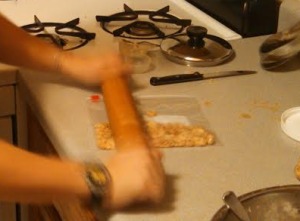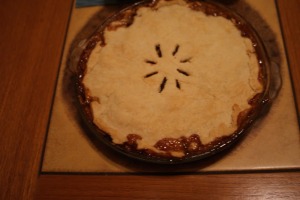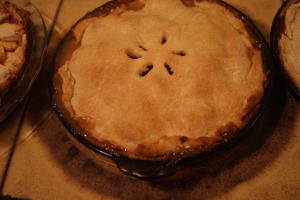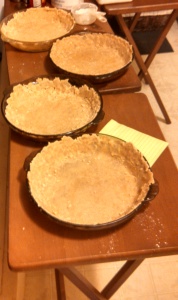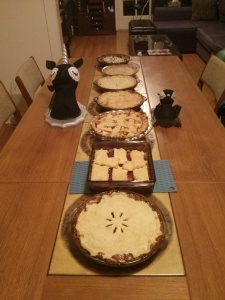Cranberries are a Thanksgiving classic, so A and I were delighted to make not one, but two cranberry pies. One sweet, and one savory, we liked them both a lot!
First, the savory. Originally, this recipe was for pork and cranberries, but we did a vegan switch and subbed seitan for the piggy, and liquid smoke and some smoked salt for the bacon. The result was delicious. Even meat and potatoes people liked it!
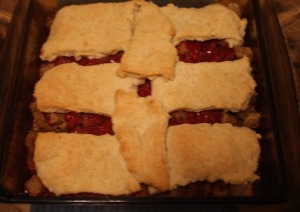
Here’s how it went down:
Ingredients:
Enough seitan to fill a pie dish. I used the Viva la Vegan recipe for white seitan, which is steamed. I think I used about four loaves of seitan, chopped up, probably about 3 cups.
1 tsp of sage, or meat rub, or thyme, or anything tasty.
quarter cup flour
A solid shake of liquid smoke.
A solid shake of smoked salt.
1 cup ground cranberries
one third cup sugar
1 cup hot water
1 biscuit crust: 1 cup flour, 1.5 tsp baking powder, .5 tsp salt, .25 cup margarine, one third cup almond milk
Directions:
Pre-heat oven to 400 degrees.
- Mix the herbs, flour and salt together. Toss seitan to coat. Pan fry in a little margarine, until browned and delicious. Place in a casserole dish, or a deep pie pan.
- Combine the cranberries and sugar, and sprinkle over the seitan. Pour cup of hot water over all, and stick it in the oven.
- While that’s baking, mix up your biscuit crust. Combine the dry crust ingredients, and cut margarine into it until crumbly. Add milk, stir. Knead it a few times, then roll it out, ideally between sheets of parchment paper. Cut into strips, or circles, or whatever seems cool to you.
- Take the seitan cranberry mix out of the oven, place biscuits on top, return to oven.
- Bake for about 20 minutes, or until golden brown.
Our sweet cranberry venture was a Harvest Apple-Cranberry Pie. Of all our pies, this is the only recipe I’d tweak for recipe, rather than vegan reasons. It just didn’t set, and while delicious, I think it would be improved by more cooking, which is reflected here. However, the flavor was fantastic.
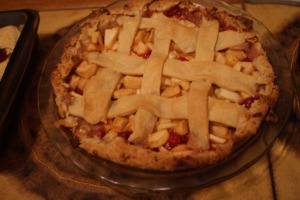
Ingredients:
2 piecrusts (bonus recipe for peanut pie crust below!)
.75 cup sugar
3 TBSP cornstarch
.25 tsp salt
.75 cup corn syrup
.25 cup water
1.5 cups raw cranberries
2 tsp. grated orange peel
1.5 cups chopped apples
2 TBSP margarine.
Directions:
- Heat oven to 425 degrees.
- Mix sugar, cornstarch, and salt together in a saucepan. Add corn syrup and water slowly. Cook over medium heat, stirring constantly, until mixture thickens to a filling-like consistancy.
- Add cranberries and continue to cook until their skins pop, add orange peel. Cool mixture.
- Add apples to the mixture, pour into piecrust. Dot the top with margarine, add top crust and seal and vent the pie.
- Bake for 40-50 minutes.
For this pie, we branched out, and made a Peanut Pie Shell. It was delicious. Here’s the recipe.
Ingredients:
1 cup flour (you should probably sift it)
.5 tsp baking powder
.5 tsp salt
one third cup vegetable shortening
one quarter cup crushed salted peanuts
3 to 4 TBSP cold water
Directions:
- Crush the peanuts by putting them in a plastic bag, and banging on them with your rolling pin.
- Sift dry ingredients together.
- Cut in shortening.
- Add peanuts.
- Sprinkle cold water over mixture, a little at a time, until dough holds together in a ball.
- Roll it out. Put it in a pie pan.
- Bake at 425 degrees for 15 minutes before filling.
This crust would be fantastic with a chocolate filling, or a regular apple pie filling.
